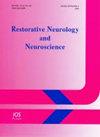Cognitive Network Changes After Exposure to Haptic Vibrotactile Trigger Technology: Results From The ENHANCE Study
IF 1.6
4区 医学
Q4 NEUROSCIENCES
引用次数: 0
Abstract
The conceptual framework of cognitive networks, or cognits, represents a system of working memory, especially long-term memory arrays that are intrinsically designed to attain certain behavioral ends and that are activated by a neural structure. Despite the fact that cognitions can be used in a plethora of systems, current technologies allow manipulations of the central nervous system (CNS) to execute certain sensory and motor functions. Sensation and tactual perception by the skin are an innate mechanism for human survival and represent our adaptive somatosensorial ability to apprehend information via haptics—the active touch for object recognition and perception by higher centers of the brain. The somatosensation, which is identified by a set of channels and receptors sensitive to a variety of stimuli (thermal, tactile, and mechanical), is critical to survival, balance control, cognition, and pain modulation. Cognits are cutting-edge tools and modalities that provide a landscape of theoretical assets, evidencebased experimental protocols, computational intelligence schemes, and direct empirical modalities that facilitate the understanding of the complex functionalities of the human brain. By evaluating neuroimaging data after somatosensory stimulation and collected via electroencephalogram (EEG), cognition response and change can be obtained that allows researchers to gain a better understanding of emerging scientific approaches aimed at understanding human behavioral outcomes. An emerging technology, haptic vibrotactile trigger technology (VTT), incorporates somatosensory patterns in compression sleeves. eSmartr Smart Compression Sleeves (Srysty Holdings Inc., Mississauga, ON, Canada) with VTT and its Cognitive Boost Technology (CBT) pattern is designed to optimize neural communications for improved mindful wellness. This technology has also been incorporated into patches, braces, apparel (socks), wrist bands, and other routes of delivery. Mindful wellness is considered an outcome of somatosensory intervention that modulates the behavioral responses associated with cognitive networks. Currently, there is limited research exploring these modalities, exposing the need to study new technologies and their influence on somatosensory pathways and cognitive networks. The purpose of this IRB-approved study was to explore the effects of forearm VTT stimulation patterns on cognitive networks by comparing a baseline EEG to an EEG after placing a sleeve incorporating VTT on the right or left forearm of adult healthy individuals. Materials and methods: A baseline EEG was recorded over 5 minutes from 19 scalp locations on 20 subjects ranging in age from 17.6 years to 41.9 years (n=7 females, 13 males). The subject’s dominant arm was then fitted with the eSmartr Smart Compression Sleeve for 20 minutes and another 5-minute EEG was recorded. Both the LORETA (Low Resolution Electromagnetic Tomography Analysis) inverse solution and a power spectral analysis of the surface EEG were calculated. Additionally, for 10 distinct networks, the current sources from 88 Brodmann areas were computed. The variables were absolute power and absolute current density in 1 Hz increments in 10 frequency bands (delta, theta, alpha-1, alpha-2, beta-1, beta-2, beta-3, and hi-beta). Paired t-tests were computed for each individual for all EEG parameters, as well as group paired t-tests, between the baseline EEG and followup EEG. Results: The results showed statistically significant t-test differences (P < 0.01) in both the surface EEG and the LORETA current sources between the baseline measurement and the follow-up ‘sleeve-on’ measurement. The largest differences were detected with a prominent downregulation of alpha and beta frequency powers at both the surface EEG and the LORETA current sources with the “sleeve-on,” as compared to baseline. In addition, the maximal effects of the “sleeve-on” condition were in the left frontal and left temporal surface EEGs and on the medial bank of the somatosensory cortex in the range of the alpha frequency. Changes in the default network and attention network were also prominent. Conclusions: Study results indicate that these non-pharmacologic, non-invasive, haptic vibrotactile trigger technology (VTT) patterned compression sleeves elicited a response in multiple cognitive networks. These networks play a key role in executive function, memory, attention, mood, and information flow. There was a prominent effect of the haptic vibrotactile trigger technology with the CBT- patterned sleeves on the EEG that was primarily located in alpha and beta frequency bands. The substantial impacts on the homuncular projection of the arm to the medial somatosensory cortex as well as the default network demonstrated activity influenced by the patterned sleeve. The mechanisms of action of the VTT sleeve on the brain, neuropathways, and the EEG spectrum are still being investigated. If results are confirmed with further research, this novel VTT technology could be a promising addition as a non-invasive and non-drug treatment approach for a variety of conditions and therapeutic applications.接触触觉振动触觉触发技术后认知网络的变化:来自ENHANCE研究的结果
认知网络(cognits)的概念框架代表了一种工作记忆系统,尤其是长期记忆阵列,其本质上是为了达到某种行为目的而设计的,并由神经结构激活。尽管认知可以用于大量的系统,但目前的技术允许操纵中枢神经系统(CNS)来执行某些感觉和运动功能。皮肤的感觉和触觉感知是人类生存的一种先天机制,代表了我们通过触觉来理解信息的适应性体感能力,触觉是大脑高级中枢对物体识别和感知的主动触觉。躯体感觉是由一系列对各种刺激(热刺激、触觉刺激和机械刺激)敏感的通道和受体识别的,它对生存、平衡控制、认知和疼痛调节至关重要。认知是前沿工具和模式,提供了理论资产、基于证据的实验协议、计算智能方案和直接经验模式的景观,促进了对人类大脑复杂功能的理解。通过评估体感刺激后的神经成像数据,并通过脑电图(EEG)收集,可以获得认知反应和变化,使研究人员能够更好地理解旨在理解人类行为结果的新兴科学方法。一种新兴技术,触觉振动触觉触发技术(VTT),将体感模式整合到压缩套管中。eSmartr智能压缩套筒(Srysty Holdings Inc., Mississauga, ON, Canada)具有VTT及其认知促进技术(CBT)模式,旨在优化神经通信,以改善意识健康。这项技术也被应用到贴片、牙套、服装(袜子)、腕带和其他运输方式中。正念健康被认为是调节与认知网络相关的行为反应的体感干预的结果。目前,探索这些模式的研究有限,表明需要研究新技术及其对体感通路和认知网络的影响。本研究旨在探讨前臂VTT刺激模式对认知网络的影响,方法是通过比较健康人在右前臂或左前臂放置带有VTT的套筒后的基线脑电图与脑电图。材料和方法:对20名年龄17.6 ~ 41.9岁的受试者(女性7名,男性13名)的19个头皮位置进行5分钟的基线脑电图记录。然后,受试者的主臂安装eSmartr智能压缩套筒20分钟,并再次记录5分钟的脑电图。计算了低分辨率电磁层析分析(LORETA)逆解和表面脑电图的功率谱分析。此外,对于10个不同的网络,计算了来自88个Brodmann区域的电流源。变量是在10个频段(delta、theta、alpha-1、alpha-2、beta-1、beta-2、beta-3和hi-beta)中以1hz增量的绝对功率和绝对电流密度。对每个个体的所有脑电图参数进行配对t检验,并在基线脑电图和随访脑电图之间进行组配对t检验。结果:t检验差异有统计学意义(P <在基线测量和后续“套上”测量之间,表面脑电图和LORETA电流源均为0.01)。与基线相比,最大的差异是表面脑电图和LORETA电流源的α和β频率功率显著下调。此外,在α频率范围内,“套袖”条件对左额叶和左颞叶表面脑电图以及体感皮层内侧的影响最大。默认网络和注意网络的变化也很突出。结论:研究结果表明,这些非药物、非侵入性、触觉振动触觉触发技术(VTT)模式的压缩套筒引起了多个认知网络的反应。这些网络在执行功能、记忆、注意力、情绪和信息流中起着关键作用。触觉振动触觉触发技术与CBT模式套筒对主要位于α和β频段的脑电图有显著的影响。对臂向内侧体感皮层和默认网络的巨形投影的实质性影响表明,图案袖影响了活动。VTT套筒对大脑、神经通路和脑电图谱的作用机制仍在研究中。 如果结果得到进一步研究的证实,这种新型的VTT技术可能是一种有希望的非侵入性和非药物治疗方法,可用于各种疾病和治疗应用。
本文章由计算机程序翻译,如有差异,请以英文原文为准。
求助全文
约1分钟内获得全文
求助全文
来源期刊
CiteScore
5.40
自引率
3.60%
发文量
22
审稿时长
>12 weeks
期刊介绍:
This interdisciplinary journal publishes papers relating to the plasticity and response of the nervous system to accidental or experimental injuries and their interventions, transplantation, neurodegenerative disorders and experimental strategies to improve regeneration or functional recovery and rehabilitation. Experimental and clinical research papers adopting fresh conceptual approaches are encouraged. The overriding criteria for publication are novelty, significant experimental or clinical relevance and interest to a multidisciplinary audience. Experiments on un-anesthetized animals should conform with the standards for the use of laboratory animals as established by the Institute of Laboratory Animal Resources, US National Academy of Sciences. Experiments in which paralytic agents are used must be justified. Patient identity should be concealed. All manuscripts are sent out for blind peer review to editorial board members or outside reviewers. Restorative Neurology and Neuroscience is a member of Neuroscience Peer Review Consortium.

 求助内容:
求助内容: 应助结果提醒方式:
应助结果提醒方式:


